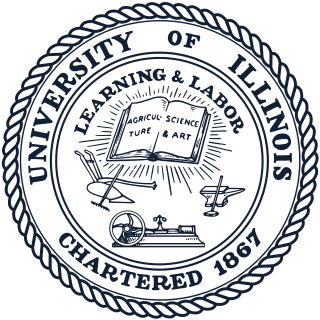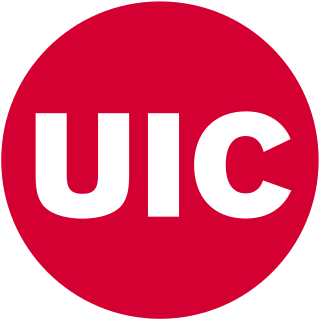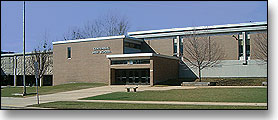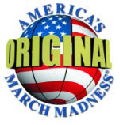
Champaign is a city in Champaign County, Illinois, United States. The United States Census Bureau estimates the city was home to 88,909 people as of July 1, 2019. Champaign is the ninth-most populous city in Illinois, and the state's fourth-most populous city outside the Chicago metropolitan area. It is included in the Champaign–Urbana metropolitan area.

Urbana is a city in and the county seat of Champaign County, Illinois, United States. The population is estimated at 42,214 as of July 1, 2019. Urbana is the tenth-most populous city in Illinois outside of the Chicago metropolitan area. It is included in the Champaign–Urbana metropolitan area.

The University of Illinois System is a system of public universities in Illinois consisting of three universities: Chicago, Springfield, and Urbana–Champaign. Across its three universities, the University of Illinois System enrolls more than 90,000 students. It had an operating budget of $6.97 billion in 2020.

The University of Illinois at Chicago (UIC) is a public research university in Chicago, Illinois. Its campus is in the Near West Side community area, adjacent to the Chicago Loop. The second campus established under the University of Illinois system, UIC is also the largest university in the Chicago area, having more than 33,000 students enrolled in 16 colleges. It is classified among "R1: Doctoral Universities – Very high research activity".

The University of Illinois at Urbana–Champaign is a public land-grant research university in Illinois in the twin cities of Champaign and Urbana. It is the flagship institution of the University of Illinois system and was founded in 1867.

Science Olympiad is an American team competition in which students compete in 23 events pertaining to various scientific disciplines, including earth science, biology, chemistry, physics, and engineering. Over 7,800 middle school and high school teams from 50 U.S. states compete each year. U.S. territories do not compete; however, since 2012 high school teams from Japan have competed at the national tournament as unranked guests.
Auburn High School is a public high school located in Rockford, Illinois, US, housing close to 2,000 ninth- through twelfth-grade students living in the Rockford school district.
Science, technology, engineering, and mathematics (STEM), previously science, mathematics, engineering, and technology (SMET), is a broad term used to group together these academic disciplines. This term is typically used to address an education policy or a curriculum choices in schools. It has implications for workforce development, national security concerns and immigration policy. The science in STEM typically refers to two out of the three major branches of science: natural sciences, including biology, physics, and chemistry; and formal sciences, of which mathematics is an example, along with logic and statistics. The third major branch of science, social science such as: psychology, sociology, and political science, are categorized separately from the other two branches of science, and are instead grouped together with humanities and arts to form another counterpart acronym named HASS - Humanities, Arts, and Social Sciences, rebranded in the UK in 2020 as SHAPE. Psychology however is considered a major part of STEM, besides the other 2 subjects. In the United States/ United Kingdom education system, in elementary, middle, and high schools, the term science refers primarily to the natural sciences, with mathematics being a standalone subject, and the social sciences are combined with the humanities under the umbrella term social studies.
The Graduate Aptitude Test in Engineering (GATE) is an examination that primarily tests the comprehensive understanding of various undergraduate subjects in engineering and science for admission into the Masters Program and Job in Public Sector Companies. GATE is conducted jointly by the Indian Institute of Science and seven Indian Institutes of Technologies at Roorkee, Delhi, Guwahati, Kanpur, Kharagpur, Chennai (Madras) and Mumbai (Bombay) on behalf of the National Coordination Board – GATE, Department of Higher Education, Ministry of Education (MoE), Government of India.
The Engineering Campus is the colloquial name for the portions of campus surrounding the Bardeen Quadrangle and the Beckman Quadrangle at the College of Engineering at the University of Illinois at Urbana–Champaign. It is an area of approximately 30 square blocks, roughly bounded by Green Street on the south, Wright Street on the west, University Avenue on the north, and Gregory Street on the east.

Vernon Hills High School, or VHHS, is a public four-year high school located in Vernon Hills, Illinois, a northern suburb of Chicago, Illinois, in the United States. It is part of Community High School District 128, which also includes Libertyville High School. The school is a blue ribbon of excellence school.

Centennial High School is a public high school serving grades 9-12 in Champaign, Illinois, USA. It is part of Champaign Unit 4 School District. As of the 2014-15 school year, it had 1,440 students. The principal is currently Charles Neitzel. The school is located next to Jefferson Middle School and Centennial Park.

The VNUHCM University of Technology is a member university of Vietnam National University, Ho Chi Minh City and is the flagship university in technology teaching and research activities in Vietnam.

The Illinois High School Boys Basketball Championship is a single elimination tournament held each spring in the United States. It is organized by the Illinois High School Association (IHSA).

The University of Illinois Laboratory High School, also known as Uni High or just Uni, was established in 1921 and is a laboratory school located on the engineering section of the University of Illinois campus in Urbana, Illinois. Its enrollment is approximately 300 students, spanning five years. The school is notable for the achievements of its alumni, including three Nobel laureates and a Pulitzer Prize winner. In 2006 and 2008 it was recognized as a "public elite" school by Newsweek because of its students' high scores on the SAT. Before the recent change in the SAT's format, the average SAT score was 2045, and now varies from 1400 to 1600. The average ACT score is a 32.

The GraingerCollege of Engineering at the University of Illinois at Urbana–Champaign was first established in 1868, and is considered one of the original units of the school. The presence of a steam engine on the University's seal indicates as to the importance of the engineering program to the University.
Rhonda Jo Hughes is an American mathematician, the Helen Herrmann Professor Emeritus of Mathematics at Bryn Mawr College.
A Beckman Fellow receives funding, usually via an intermediary institution, from the Arnold and Mabel Beckman Foundation, founded by Arnold Orville Beckman and his wife Mabel. The Foundation supports programs at several institutions to encourage research, particularly the work of young researchers who might not be eligible for other sources of funding. People from a variety of different programs at different institutions may therefore be referred to as Beckman Fellows. Though most often designating postdoctoral awards in science, the exact significance of the term will vary depending on the institution involved and the type(s) of Beckman Fellowship awarded at that institution.
The University Library at the University of Illinois at Urbana–Champaign is the network of libraries, including both physical and virtual library spaces, which serves the University's students, faculty, and staff, as well as scholars and researchers worldwide. The University Library continues to evolve to serve the needs of the University of Illinois at Urbana–Champaign campus.
The Carle Illinois College of Medicine is the graduate medical school of the University of Illinois at Urbana Champaign. Called the "World's First Engineering-Based College of Medicine," the school trains physician-innovators by integrating several engineering and entrepreneurship approaches to healthcare into its medical training, and awards the degree of M.D. upon graduation.










